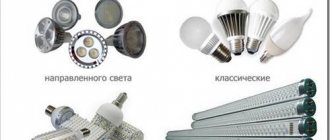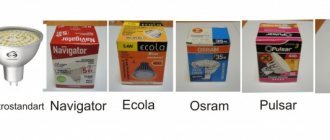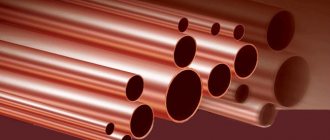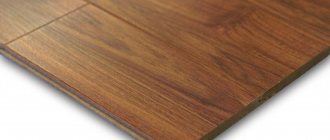LED lamps are economical, effective elements for arranging a practical and comfortable household lighting system. They provide good light flow, consume minimal electricity, withstand impressive operating loads and operate for a long time.
These qualities make products attractive to consumers and stimulate growth in demand for products. However, choosing the right option from the variety of assortments is not so easy, don’t you agree? We will help you determine the best LED lamps that are optimal for your specific operating conditions.
The article provides a detailed classification of LED lamps, identifying parameters and characteristics that should definitely be taken into account when choosing devices. In addition, we have prepared a review of the best manufacturers whose lamps have proven their quality and reliability in practice.
Main types of products
Unlike traditional incandescent lamps, LED sources do not have strict design features and are available in a wide variety of, sometimes very unexpected, configurations. This allows them to be built into modern and vintage lamps of any type.
Classification is carried out into three subspecies. The first category includes general purpose products. They are distinguished by high-quality light flux with a dispersion angle from 20° to 360° and are intended for lighting offices and residential premises for various purposes.
Using general-purpose LED lamps, you can organize a household lighting system of any complexity. It will work properly while consuming a minimal amount of electrical energy
The second block includes directional light modules operating on one or more LEDs. The use of these products allows you to create accent lighting and highlight certain areas or interior elements in the room.
LEDs designed to create directional lighting have a specific design and are called spots. Suitable for installation in furniture, shelf and wall mounting
LED linear lamps look like classic fluorescent fixtures. They are made in the form of tubes of different lengths.
They are mainly used in technical rooms of a house or apartment, in offices and sales areas, where bright and economical lighting is required that can highlight all the details.
Linear LED lighting is available for use in low voltage systems. This makes it possible to use it in the kitchen, where, due to increased humidity, more stringent requirements are imposed on lighting sources
Using LED modules of linear and other types, you can competently and beautifully arrange high-quality lighting for confined spaces and local areas where fire safety is a priority.
Power
Power is not the main technical parameter when choosing an LED light bulb, but it is perceived as one of the most important, since electricity consumption and efficiency depend on it. Compared to ordinary incandescent light bulbs, they consume much less energy.
We recommend watching the thematic video:
There is a power marking on the housing and packaging of LED devices. It ranges from 3 to 25 W. Basically, the parameter is indicated by the letters “P” or “W”. People who are used to using 100-watt incandescent bulbs can purchase a 15-watt LED bulb and it will illuminate the room the same way but use less energy.
The chips require less voltage, but are still capable of emitting greater brightness. For example, LED products with a power of 10 W will correspond in brightness to a classic incandescent light bulb with a power of 75 W. To find out about the rest of the comparative characteristics, check out the table below.
Table of correspondence between the brightness of incandescent and LED lamps.
When purchasing an LED lamp, it is worth remembering that inexpensive Chinese products are less powerful and do not correspond to the markings indicated on the package. The difference between an expensive lamp and a cheap one can vary within 5 W. It is recommended not to purchase such lighting devices.
Types of LEDs used
Additionally, the devices differ from each other in the type of diodes installed in the lamp body.
indicator elements are considered obsolete and are extremely rare in everyday life. The quality of the light output and the overall safety of these products do not meet the requirements accepted today.
SMD chips are the most common and most widely used type. The minimal size and low base heating of the working elements make SMD lamps the most attractive among analogues.
Their use has no restrictions and is allowed in any systems and conditions.
The only disadvantage of SMD-type diodes is their small size. Because of this, you need to install them in a light bulb in large quantities, and this is not always convenient or advisable.
Units operating on high-power diodes of 1.3 and 5 W can be very productive in some situations.
But the high level of heating during operation and the difficulty of organizing correct heat removal from a small case significantly reduce their popularity.
If any problems arise with the light bulb, it is not necessary to immediately run to the store and demand an exchange or refund. Simple problems can be easily fixed at home, even by craftsmen who do not have much experience in such work.
COB diodes are an innovative chip manufacturing technology. It is being developed very actively now. Due to direct mounting of diodes on the board, heat dissipation increases significantly, and the overall reliability of the device increases.
Thanks to the improved optical system, the light flow is distributed more evenly and creates a pleasant background glow in the room.
Filament is a progressive type of chip, invented in 2013-2014 by a group of scientists. Intended for lighting purposes only.
It is fully used for arranging original and unusual decorative lighting for domestic and industrial premises for various purposes.
A light bulb with filament-type diodes has all the useful features characteristic of LED sources. It looks stylish and attractive, lasts a long time, consumes a minimal amount of energy and provides uniform illumination of the room within a 360° radius.
Provides a spectrum of light that is pleasant to the human eye, similar in characteristics to the burning effect of a traditional incandescent lamp. In this parameter it is many times superior to similar SDM and COB type products.
In company stores it is sold at a reasonable price and is considered a practical option for an economical light source.
Dimmer
Not all models can be connected to a dimmer. This feature should be read on the packaging upon purchase. In addition, the packaging must contain information about the manufacturer, indicate the lamp power and warranty period. The type of base and luminous flux, color temperature and color rendering coefficient must be indicated. You can also see a barcode on the packaging.
Product Specifications
LED lamps have a wide range of technical characteristics.
The main criteria that determine the effectiveness and purpose of the modules are:
- type of base element;
- power level and light flux;
- color temperature range;
- basic color rendering;
- ability to dissipate.
Knowing the features of these parameters, choosing the best LED lighting option for yourself will not be difficult.
Types of current bases
The choice of base is carried out for a specific lamp available. The bulk of products designed to replace classic incandescent lamps have a simple screw base labeled E14, with bases E27 and E40. This size and configuration is considered universal.
Even the most sophisticated and progressive LED light bulb with an E27 socket is suitable not only for a catchy, stylish and unusual modern lamp, but also for an old grandmother’s chandelier bought 50 years ago
If you need to change halogen lamps, you will need LEDs with a pin base class G4, GU5,3, GU10.
To integrate lighting into furniture sets, sideboards or cabinets, products with a GX53 base are suitable.
Tube radiator accessories
Radiator devices that ensure correct heat dissipation in modern bulb LED lamps are:
- aluminum - ribbed or smooth;
- composite;
- ceramic;
- plastic.
Ceramic ones do not conduct current and are more expensive than all others.
Composite ones remove heat efficiently, do not pose a danger to humans and are sold for reasonable money.
Aluminum ones are considered reliable and efficient, but they conduct current well and can cause injury or burns upon direct contact.
Modules equipped with a ceramic or aluminum base are usually installed in a suspended ceiling lighting system, since in this case the requirements for heat dissipation are critical, and overheating can cause a change in the structure of the fabric and loss of the primary color
Plastic ones belong to the cheapest segment, however, they cope with the assigned tasks quite well. Their main trump card is the low price, which, in spite of everything, attracts buyers.
Features of device power
The luminous efficiency of LED products is measured in watts. Consuming a minimal amount of electricity, LED lamps produce a record large amount of light, almost 10 times greater than the capabilities of classic incandescent modules.
One ice product with a power of 9-10 W provides optimal light flow and successfully replaces a 100-watt Ilyich light bulb.
The table shows how many watts LED products produce compared to other similar devices. This cheat sheet can be downloaded to your gadget and always kept at hand so as not to forget the parameters when purchasing (+)
This allows customers to receive high-quality lighting without compromising their own comfort and significantly save on utility bills.
Quality of light flow
The luminous flux produced by standard LED products varies in Lumens. A light bulb with a diameter of 5 millimeters produces from 1 to 5 lumens of directional light.
Brands always indicate the radiation intensity level of their products on the packaging. Having this information makes it easier to select a lamp for a specific task.
The efficiency of an LED fixture is determined by the relationship between the power in watts and the light output in lumens. The resulting numbers are usually indicated on the front side of the branded packaging of the light bulb
To make it easier to navigate, you need to remember that a standard 100-watt incandescent module provides a light flux of 1000 lm.
If a smaller number is indicated on the box of an LED product, it means the lighting in the room will be weaker. Large indicators indicate that the lamp will easily and efficiently illuminate a large room.
The nuances of color temperature
The peculiarity of LEDs is that they have different light temperatures. This makes it possible to choose the most suitable shade of emitted light flux for each individual room, depending on its purpose.
Even the classic white range is represented by several colors at once:
- 2700K – soft white with a delicate reddish tint. Creates an atmosphere of calm, warmth and comfort in the room. Most often found in low and medium wattage lamps.
- 3000K – warm white with a slight yellow tint. Great for living rooms, children's rooms, bedrooms or living rooms. Gives a feeling of security and relaxation.
- 3500K – natural neutral white. Does not distort color perception and does not put strain on the eyes.
- 4000K – cool white. Effectively illuminates the space, emphasizes cleanliness, and gives clear contours to all objects. Stimulates performance and brain activity, suitable for classrooms, offices, etc.
- 5000-6000K – classic daytime white with a high brightness rating. It is considered too harsh for residential premises and is used to illuminate large spaces in workshops, industrial complexes and greenhouses.
- 6500K – cool daytime with a pronounced bluish tint. Promotes concentration and instills some anxiety. Suitable for hospitals and various technical premises.
In addition to the above options, there are color LED modules on sale that allow you to set up an exclusive home lighting system and create an individual lighting option for each corner of your apartment or house.
Description of color rendering index
The basic color rendering index is indicated by the abbreviation CRI (Color Rendering Index) and numbers from 0 to 100. It shows how clearly and competently the lamp conveys the shades of surrounding things and objects.
A module with an indicator of 100 units does not create any distortion at all and displays all colors absolutely accurately. However, you will have to pay a significant amount for such an element.
If there is a need to illuminate paintings in your home interior, it is better to install an LED with a CRI value of 100. Then the image will not lose its beauty and the colors will remain exactly as the artist intended
Whether this is appropriate, the client will have to decide for himself. Experts advise not to overpay extra money and select home light sources in the CRI range of 80 and slightly higher.
Flow dissipation parameters
All LED elements shine clearly in front of you. A minimal amount of light waves are deflected to the side and create a small halo.
The working scattering angle of each module directly depends on how the crystals are located inside the lamp and how many there are in total.
The scattering angle of LED lamps ranges from 30 to 360 degrees. This allows you to install modules with different dispersion values in lighting fixtures, achieving original lighting that emphasizes the interior design solution
Such characteristics make it possible to obtain both a beam of light directed at a certain point and a soft, diffused glow, conducive to a calm, relaxed rest.
For lamps for different purposes, there are optimal light dispersion indicators. It is recommended to install products with a dispersion angle of 90-180° in a ceiling lamp or chandelier that creates background lighting.
With this approach, it will be possible to correctly and as brightly illuminate the center of the room as possible, while leaving the corners and perimeter of the room slightly darkened.
In devices designed to illuminate a small area, for example, a reading area or spot lighting of paintings and other elements of interior decor, it is worth using products that deliver a narrow beam with a dispersion coefficient of 30° to 60°.
Using lamps of different dispersion levels, you can organize a very original and attractive lighting system in the room, adding interesting accents to the overall style solution
In decorative sconces or lamps with slots, you can install a lamp with a scattering angle of 360 degrees. It will create an unusual glow effect that changes depending on the point of view of the room.
A few words about service life
The basic working life of LED products is measured in hours. Serious manufacturers are very proud of this parameter and display it on the front of the package. The numbers indicate how long the purchased product will work under correct operating conditions.
The average lifespan of LED light bulbs is 10 years or 30,000 hours. In products of the more expensive segment, this figure reaches 50-60 thousand hours, which equals 15-18 years.
True, the manufacturer does not inform the buyer that LEDs tend to burn out and over time lose their original brightness.
For branded devices this happens towards the end of their service life. In unnamed Chinese light bulbs, such an unpleasant moment may appear already in the first 6 months after purchase.
Radiator
The radiator is an important design element of the LED lamp, which affects the service life. Different materials are used:
- Plastic. Applicable only for low power LED crystals. The products are inexpensive.
- Aluminum. It has high heat dissipation performance, but contact may result in electric shock or burns.
- Composite Provides safety and increases thermal conductivity.
- Ceramics. Provides electrical insulation; devices are highly expensive.
Types of radiators.
It is better to buy devices with ceramic or aluminum radiators for a suspended ceiling. Only they will ensure sufficient heat dissipation in a confined space and reliability without negatively affecting technical performance.
Current manufacturers and models
Leading positions in the market segment of LED equipment and related elements are occupied by European concerns Philips and Osram .
They offer the client the widest range of certified products that meet all the most stringent international requirements for the quality of light sources.
LED lamps from Phillips and Osram are considered to be among the most reliable; they can withstand intense operating loads and fill rooms with pleasant light that is not irritating to the eyes.
Products from Russia demonstrate normal quality at a low price. The line of LED products includes lamps of various configurations, including modules designed for installation in furniture.
Ice lamps produced under the Gauss . The brand sells both budget and premium modules and provides a 3-year warranty on its products.
For an LED lamp to live up to your expectations, you should buy it not at the market or a table near the metro, but in specialized brand stores. This will help protect against defective or downright low-quality products.
The Russian company Era is a newcomer to the LED market, however, its consistently high-quality products have already attracted the attention of clients.
Now the company is actively developing production and in the future it plans to squeeze out competitors and even get ahead of them in the battle for buyers.
Resources
Another important characteristic of the product is its working resource. Today's developments and research show a figure of 50,000 hours. But, this is not entirely true. This figure is reliable under ideal conditions of use. It is worth remembering that LEDs degrade over a certain period of time. Their quality characteristics deteriorate significantly.
Therefore, when choosing, pay attention to the warranty period of the product. This indicator is worth starting from. Most often, this is 3–5 years, during which, if it breaks, you can replace the product with a new one.
The following practice has been noticed: domestic manufacturers set a service life that does not exceed 3 years. Foreign companies, on the contrary, establish a warranty period of about 5 years.
Recessed lamps: typesChandeliers: how to choose a product and which manufacturer to choose
Ceiling chandelier - stylish design options, features of installation, connection and placement (100 photos of ideas and new products)
Useful tips for choosing
When choosing a lamp based on LED elements, you need to find an environmentally friendly, economical and safe product with a suitable glow temperature, no flicker, optimal light output and the correct dispersion angle.
The lighting system, equipped with warm spectrum lamps, creates a feeling of comfort and a relaxed, intimate atmosphere in the bedroom. The soft glow does not irritate the eyes, calms and has a calming effect on a person
If you need to illuminate a living space, you should take a module from the warm spectrum marked 2700-3200 K. This will provide a pleasant atmosphere in your house or apartment, conducive to spending a long time in the rooms for the purpose of relaxation or communication.
You can install 3700-4200 K lamps in the bath, kitchen, hallway or bathroom. They will fill the room with bright, neutral white light, reminiscent of the glow of the morning sun.
All objects with this lighting option will acquire additional clarity and will look a little harder. But this will not cause unnecessary strain on the eyes, because a person does not spend a lot of time in such rooms.
When the goal is to provide high-quality lighting for utility rooms, it is appropriate to use lamps of 6000 K and higher. They will bring a stream of light to every corner and not a single centimeter of the room will remain in the shadow.
Flickering is one of the weak points of LED modules. Popular manufacturers claim that this drawback is characteristic only of unnamed Chinese products, and branded products do not have it.
It is very easy to verify the veracity of these words. At the time of purchase, all you need to do is screw the lamp into the base and hold your smartphone camera close to it. When the light bulb pulsates, the image that appears on the screen will certainly flicker.
Some brands will only provide warranty replacement under certain circumstances. For example, when more than 5% of the diodes in a lamp have burned out or the light flux has lost 10% saturation
In branded stores, when purchasing ice lamps, customers are provided with a guarantee from the manufacturer. It usually lasts from 1 to 3 years depending on the brand.
In order to use it and replace a faulty product with a working analogue, the buyer will have to keep the cash receipt and coupon, where the seller noted the date of purchase and certified it with his signature.
Scattering angle
This criterion is also worth taking into account. The nature of lighting is directly related to the presence or absence of a diverging lens. The location of the LEDs also plays a role. If they are on the same surface, then you will see narrowly focused lighting. Multi-level placement of particles affects the lighting; it will be diffuse.
Conclusions and useful video on the topic
Companies holding leading positions in the lighting equipment market in the segment of household LED elements. The main pros and cons of branded products:
What mistakes do customers make when purchasing LED products? How to avoid them and purchase the right LED products that will work long and reliably. Reminder for potential buyers:
We can talk for a long time about which types of modern LED lamps are better. There is no clear answer to this question. It all depends on the purpose of the lighting system and the area of its use. Based on these parameters, it is worth choosing a suitable LED product.
There is no need to purchase nameless products in order to save money. It makes more sense to choose a module from a trusted brand that has proven itself well in the market.
Do you have anything to add or have questions about choosing LED lamps? You can leave comments on the publication, participate in discussions and share your own experience of using LED lamps. The contact form is located in the lower block.
Base
LED lamps are divided into 3 classes according to the type of base:
- E – Edison base (threaded).
- G – pin base.
- T – contacts of fluorescent lamps.
Types of socles.
The most common is E. After the letter on the package there are numbers that indicate the diameter. The numbers after the letter G indicate the number of contacts. Lamps of this type are bought the least often, since they cannot be connected to a 220 volt network without connecting the power supply. Analogs of luminescent products in the marking also have numbers indicating the distance between the contacts in parts of an inch. For example, T - 8/8 or T - 5/8 inches.
Flask
Which lamps are better - with a matte or transparent bulb? The LED is a point and very bright light source. If the lamp is visible in a chandelier or lamp, for example it is directed downward, then with a transparent bulb an irritating effect may occur, similar to a welding arc.
However, the matte diffuser does not have this drawback. Decide what is best for you - even, soft and diffused light, or very bright.
An exception is crystal chandeliers and similar lamps.
For them, point and sparkling light sources are better, which give a play of light on the edges of crystal elements.
Flaws
- High price. The price level depends on the brand; high-quality European products are much more expensive.
- Most often there is no brightness adjustment; this function is present only in expensive models and allows you to change the power.
- LEDs begin to fade over time, causing the brightness to noticeably decrease.
- The flickering effect is found in cheap products from Asian manufacturers.
Ripple
How do you know if a lamp has pulsation? Every major store has the ability to check product functionality.
Turn on the light bulb and just look at it through your mobile phone camera.
If there are stripes on the screen, the lamp is pulsating.
It is not advisable to use such products in residential premises. Their purpose is to illuminate entrances, garages, corridors and utility rooms.
If there are no stripes, then the lamp does not pulsate.
Color rendition
The parameter is designated CRI and determines the clarity and realism of the surrounding colors. Naturalness increases with increasing indicator.
For residential premises, values from 80 are recommended.
Dimming
Controlling the brightness of lighting using a dimmer is a very useful and convenient feature. However, most LED lamps do not support this feature.
Finding a dimmable LED lamp of the desired shape, size, power and color is not easy and is almost always expensive.
It should be taken into account that dimming occurs by controlling the frequency parameters of the supply voltage.
And this will definitely cause pulsation on the lamp.
If you don't want ripples, skip dimming.
You can control the brightness in another way - by turning various lighting groups on and off.
Although this is less elegant, it is more effective and safer for your health.
Supply voltage
There are lamps that are produced only for 220 volts:
- models with G9 base
- reflector lamps R39, R50, R63, R80
And there are models that are available for both 12 volts and 220V. Moreover, their shapes are almost identical.
- capsule G4
- reflector MR16 with GU 5.3 base
- GX 53 tablets
TOP 3 LED models E27 (to replace 150 W lamps)
Such lamps are optimal for lighting rooms up to 25 square meters. m.
No3. Osram SST CLA150 20.3 W/827 E27 FR Dim
These LED ceiling lights are a great option for your home. They provide warm and cozy light without hesitation or flickering. The flask is made of frosted glass. The light beam scattering angle is 200 degrees. With a luminous flux of 2452 lm and a temperature of 2700 K, the power of the product is 21 W.
Osram SST CLA150 20.3 W/827 E27 FR Dim
pros
- you can connect a dimmer;
- The output indicators correspond to the declared ones.
Minuses
- no significant deficiencies were identified.
Prices for Osram SST CLA150 20.3 W/827 E27 FR Dim
Osram SST CLA150 20.3 W/827 E27 FR Dim
No2. Nanosvet E27 2700K
The lamp provides light that is pleasant and comfortable for the eyes without yellowness. It has a voltage of 220 V and a power of 18 W. The shape is cylindrical, the color temperature is 2700 K. The model can last 15 thousand hours.
Nanosvet E27 2700K
pros
- no flicker;
- can be used with switches that have backlighting.
Minuses
- not the lowest price.
Prices for Nanosvet E27 2700K
Nanosvet E27 2700K
No1. OSRAM LS CLA150
A pear-shaped lamp with bright warm light, an excellent option for large areas. At standard voltage, its power is 20.3 W, and the luminous flux is 2452 lm. The color temperature indicator is 2700 K. Lasts up to 15 thousand hours.
OSRAM LS CLA150
pros
- no blinking;
- the product begins to illuminate without “overclocking,” that is, immediately.
Minuses
- no serious deficiencies were found.
Prices for OSRAM LS CLA150
OSRAM LS CLA150
What types of LED light bulbs are there?
- Standard. These are the most common light bulbs, most often they are shaped like incandescent lamps. Available with different types of bases, suitable for any lamps, including ceiling and recessed ones.
- RGB lamps. These lamps have built-in LEDs of three shades - red, green and blue. The user has the opportunity, using the remote control, to regulate the current through each group of LEDs, obtaining a huge range of shades, including white light of any temperature. The main disadvantages of RGB lamps are strong pulsation, low color rendering index and low brightness. Most often they are used as lighting.
- Filament lamps. This is one of the latest developments by lighting equipment manufacturers - LED lamps that resemble incandescent lamps in appearance. A filament thread consisting of a glass substrate, LEDs and phosphor is used as a light source. Such a lamp does not have a radiator: excess heat is removed by filling the flask with helium or a mixture of gases based on it. The temperature of the filament thread does not exceed 60 °C. Filament LED lamps are available in a power range from 4 to 8 W and have a light temperature of 2700 K. They have low energy consumption, a wide dispersion angle and high quality light.
- Rechargeable. These are the most expensive LED lamps that can operate autonomously. They come in two types: the first switch to a backup battery only when the mains power is lost, the second always operate on battery power. Their main drawback is their high price.
- LED lamps with remote control. They come complete with an infrared or radio remote control and allow you to change the color of the glow. Light bulbs also have disadvantages: they are expensive and do not have very high quality lighting.
Light flow
This value is measured in lumens (lm) and characterizes the amount of light emitted by the lamp. The higher the value, the stronger the brightness becomes.
For example, a 2 W lamp produces 250 lm, a 200 W device produces 2500 lm.
ATTENTION. Lamps that are too bright are not recommended as they can negatively affect your vision.
Lamp efficiency
The efficiency factor (efficiency) is closely related to all previous parameters of lighting lamps. Each device has a “useful action” - this is the work for which, in fact, the device was created. The main useful effect of lamps is the emission of light. Everything else is extra and unnecessary work and reduces efficiency. Incandescent lamps have a very low efficiency, because the main part of its work is not associated with a beneficial effect, but with a side effect - heat radiation. This value (efficiency) for such lamps barely reaches 5%. This means that only 5% of the electrical energy consumed is wasted emitting light. And this is a very low figure. He talks about the inefficiency and wastefulness of the device.
LED lamps have a high efficiency of about 90%. That is, LED devices do not waste energy on useless work and save electrical energy, and, therefore, save the user’s budget.











